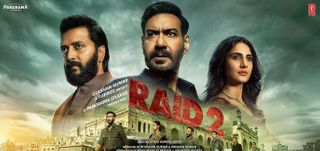Dum Movie Review
A corrupt cop barges into an honest colleague's home and tries to gas his wife to death. When she escapes, the fiend kills the cop's little daughter instead.
A brainless assassin chases an honest politician through a vegetable market and cuts him up like chicken -- in fact the sequence opens with a butcher chopping up meat.
These are just two of the harrowing sequences of street violence that cut through Dum, with the professionalism of a butcher prying into troublesome turkey at thanksgiving.
E. Niwas' third feature film is like a newspaper report. Grim, dark, traumatic and yet thrilling. In the working class hero's fight with a corrupt law enforcer, the audience might mutter: "Thank god it isn't us."
Protagonist Uday Shinde, played by Vivek Oberoi, takes on the immoral might of a villainous cop Shankar, played by Atul Kulkarni, a human being so degenerate and debased that he makes Sholay's Gabbar Singh seem like a comic strip character.
There's nothing colourful, uplifting or comforting about Dum. If you regard cinema as a form of escapist entertainment then Niwas' film is a no-no.
But if you regard cinema as a mirror of social reality then Dum is a hard sock in the jaw.
Human brutality in all its splendour has been depicted with such vividness before only in the films of Raj Kumar Santoshi. Niwas seeks inspiration from both Santoshi and his mentor Ram Gopal Varma.
Vivek Oberoi is a very believable working class hero. His bourgeois face reflects a steely determination to overcome his innate socio-economic shortcomings.
His breakdown sequence, done in a tight close-up at the hospital when his best friend dies, is unforgettable.
Finely crafted and extremely violent, Niwas moves through the streets of Mumbai like a panther on the prowl. From the opening scenes where Vivek Oberoi is chasing Sushant Singh through the narrow bylanes of Mumbai one is hooked to the goings-on.
Niwas leaves room for tensions to grow within the plot.
In his endeavour to combine craft and intuition, the director is generously aided by Surendra Rao's cinematography and R. Varman's art direction. Both the technicians till the film's landscape with a passionate plough.
Many of the sequences are framed with an in-your-face aggression. The striking theme song with balls of fire emanating from every corner of the frame ends with Vivek hurling his booted leg towards the camera.
Except for a few shared moments with family and friends and a discreet romantic interlude with the fresh-faced girl next door, Diya Mirza, there's no cheer in the protagonist's existence.
Dum is like a cloudburst. Three years ago in his unevenly paced technically shoddy debut film Shool, Niwas had portrayed a cop's fight to finish corruption.
Niwas turns around the battle between good and evil by portraying police as the fulcrum of degeneration.
Atul Kulkarni, so brilliant as the ganglord with a heart of gold in Chandni Bar, is a snarling symbol of contemptuous corruption in Dum. His villainy is a step forward in the way evil is portrayed in commercial cinema.
Vivek is controlled and in command. Unlike in Saathiya where he often strained for effect, here his character's anguish flows more effortlessly.
Apart from one aggressively done song, Sandeep Chowta's music and songs are well integrated into the plot.
Though there are some interesting incidental characters, none of the peripheral players get a prominent voice. But gifted actor Sushant Singh makes space for himself. His death scene is one of the few moist points in an otherwise staccato narrative.


















